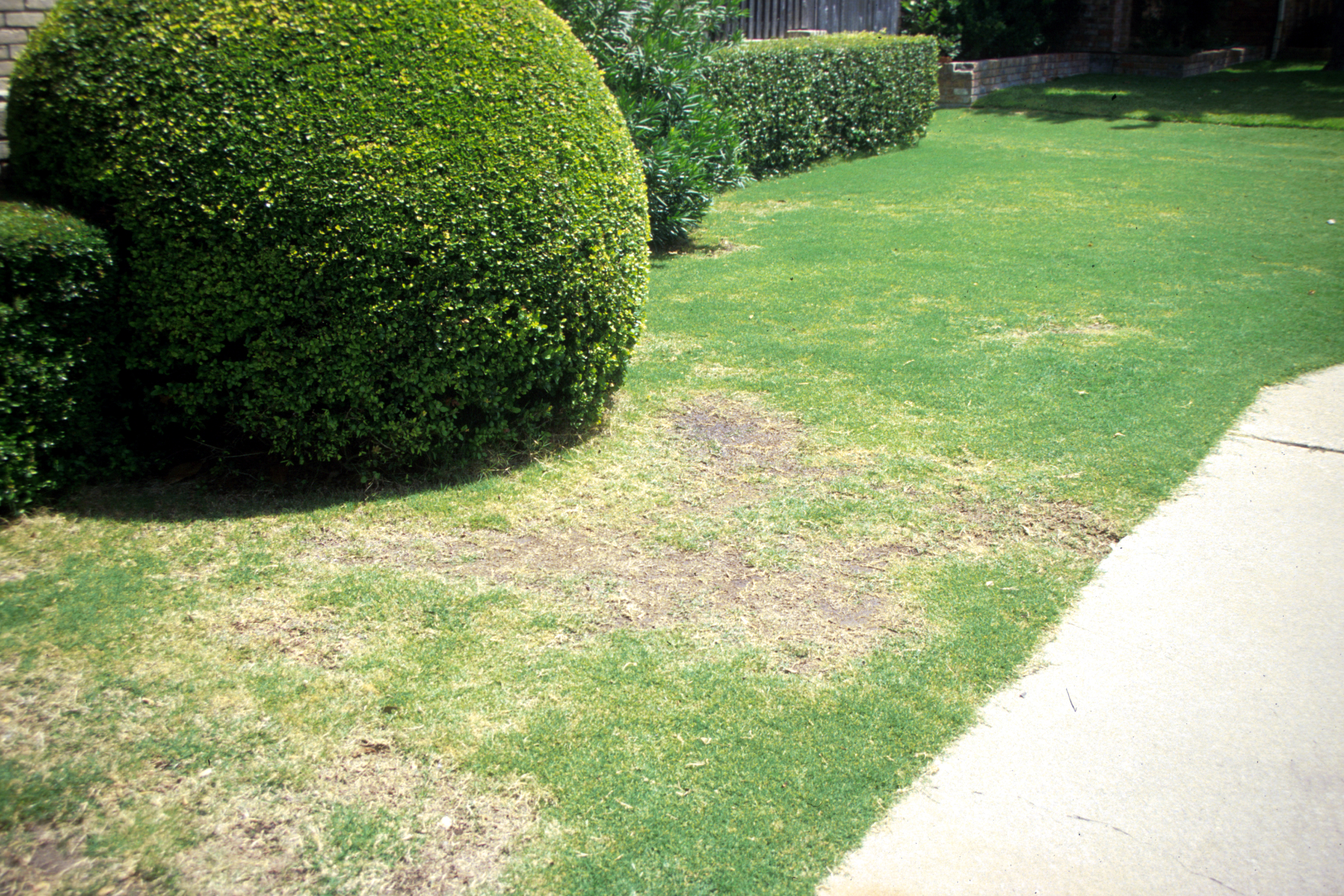A tiny turfgrass pest appears to be on the increase according to researchers and lawn care experts.

Bermudagrass stunt mite damaged grass (left) is bunchy and brown. Normal bermudagrass is on the right.
The Bermudagrass stunt mite (BSM), Eriophes cynodoniensis, is one of our tiniest arthropod pests of lawns. A relative of the mite that transmits rose rosette disease, the BSM lives inside the leaf sheaths of grass. In home yards it is pretty common (but not often recognized by homeowners as a pest). Golf course managers, on the other hand, who are expected to consistently provide billiard table-smooth putting surfaces, consider BSM a real threat.
Reasons for the increased reports of BSM may include the loss of some older insecticides, a trend toward higher mowing heights and less irrigation, and possibly the use of newer, more susceptible grass varieties.
The BSM feeds only on bermudagrass (though there are closely related species that feed on buffalograss and zoysiagrass). When the mite feeds under the leaf sheaths the leaves start to yellow and twist. As the grass tries to grow, the gaps between the leaves get shorter and shorter, resulting in a bunchy, “witches broom” appearance. Eventually the leaves and stems die, probably as a result of a toxin injected into the grass by the mite. Look for areas of stunted, green to brown grass, and dead spots in a lawn. You can identify BSM damage by the stunted, tufted appearance of the grass around the edges of the dead spots.
Once you have seen and recognize the damage caused by this mite, you will notice it in a lot more places, especially in sites with poor or no irrigation. In my own yard for several years I commonly saw BSM damage in the median strip between sidewalk and street. Since upgrading my sprinkler system, however, I see fewer signs of these mites.

Bermudagrass mite damage symptoms resemble grub damage or poor watering. When inspecting brown spots in a lawn, look for the characteristic tufts of bunchy grass around the edge of brown spots in the lawn.
Dr. J.C. Chong, of Clemson University, got interested in this mite about 10 years ago, and found no one else studying it. Today he has devoted as much time as anyone to studying these tiny pests. His knowledge about BSM is in especially high demand this year, he says.
“I am getting more requests for diagnosis and confirmation from golf courses and high-end landscapes in Florida, the Carolinas and Texas in the past 3 months than the entire [2016] combined.”
According to Chong, the last time anyone bothered to studying control of BSM was in the early 1980s. At the time, the best insecticide by far was diazinon. Now that diazinon is no longer available due to environmental concerns, we have few comparable products.
Part of the problem is that there are few researchers with time or funding to study BSM. Another problem common to turfgrass pests is that it is difficult to know if and where mites will show up in a large enough area to design a good insecticide trial.
Bifenthrin is a commonly available lawn and garden insecticide, and usually provides decent mite control. But experts vary in their opinions the effectiveness of bifenthrin against BSM. Bifenthrin and a couple of other similar insecticides, such as lambda-cyhalothrin and deltamethrin, carry labels for mite control in turfgrass. While these products may provide some control, don’t expect miracles, say experts.
Chong himself has had little success with bifenthrin, regardless of timing. In trials conducted between 2011 and 2015, he found an insecticide called avermectin to be the best treatment after diazinon. But avermectin (Avid 0.15EC) is not sold in most garden centers to consumers (it can be purchased online). When using avermectin, Chong recommends multiple (up to four) applications every two weeks.
Perhaps the best approach for the average consumer is to use bifenthrin or one of its similar products in combination with very close mowing and increased irrigation. Before applying insecticide, experts recommend lowering the mower and cutting the grass very close to the ground (scalping). This will remove many of the infested grass tufts (and mites) and open the grass canopy to permit better spray coverage. Bagging your clippings and disposing of them off site will ensure that the mites are not just spread around by the mowing operation. Also, make sure the area gets well watered until the grass has time to recover.
Despite years of field trials, Chong notes that there is still a lot to learn, especially when it comes to combining insecticides with different cultural practices like mowing, irrigation and varietal selection. Experience with BSM demonstrates that, at least for some pests, it’s not always easy to come up with reliable management recommendations. For a pest like BSM, one pest can lead to a career’s worth of work for some lucky entomologist.
